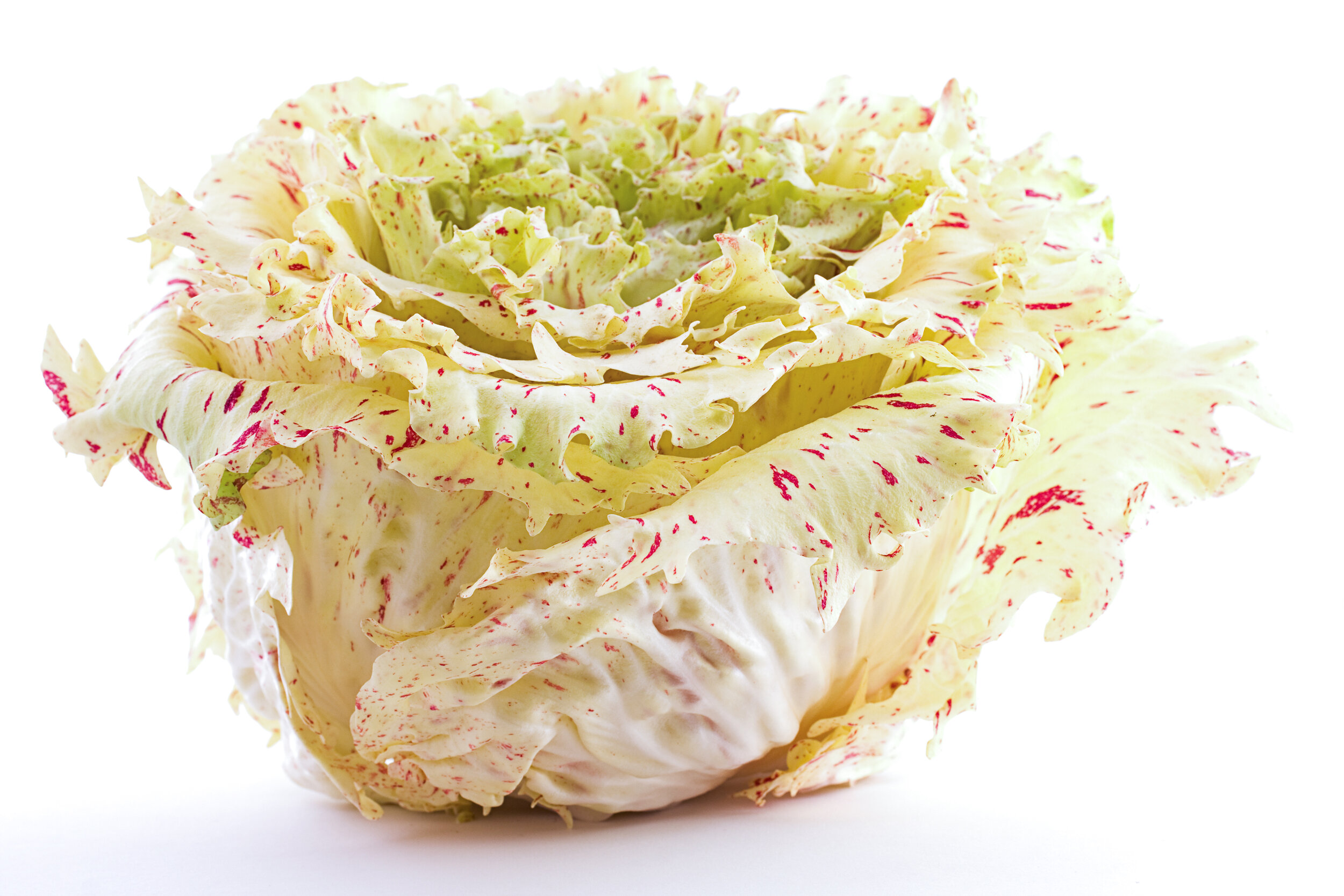Radicchio—Beautiful But Bitter (in a good way)
by Lisa Barclay, Board Member
The second veggie in our Imperfectly Delicious series is radicchio, that beautifully colored bitter green. People tend to love it or hate it. I love it, but I understand how it can be a bit overwhelming at first. I think the best way to add radicchio to your diet is mixed with other veggies, which can balance out the bitterness, and add a sweet counterpart, such as fruit. Or just put a little radicchio in your usual salad—it’s bitterness can be a lovely counterpoint to the other flavors.
Variegated Castelfranco Radicchio
Radicchio (pronounced rah-dee-key-oh) is from the chicory family. It looks like lettuce or cabbage, depending on the variety, and the colors range from light greens or almost white to deep purples. Treviso is long with compact leaves, perfect for cutting into confetti shreds for a lettuce or grain salad, while Chiogga is cabbage shaped but also shreds nicely. Castelfranco has a looser head, more like lettuce, and you can use it just like lettuce. Radicchio contains vitamin K, potassium, and phosphorus and is considered to have various health benefits, from boosting the immune system to stimulating the appetite.
You can use it raw or cooked—cooking lessens the bitterness somewhat. I use radicchio in many kinds of salads. I also sauté it with olive oil, salt, and balsamic vinegar for a side dish, but my favorite way to eat radicchio is to shredded a head and mix it into a cheesy risotto just before serving.
Recipes:
Janet of Finnriver likes to mix radicchio with shredded or julienned carrots and sweet-tart apples, tossed with a balsamic vinaigrette (her fave balsamic is Napa Valley’s Grand Reserve Balsamic).
Marko of Midori Farms has a simple but delicious recipe: Cut a whole Treviso radicchio in half lengthwise, drizzle it with olive oil and a nice balsamic vinegar, and grill or roast it. The leaves turn a little brown, but it tastes wonderful. Sprinkle with a little flaky serving salt, such as Maldon Sea Salt (my personal favorite).
Farm work trader Theresa thinly shreds radicchio (1/4 inch or less) and tosses it with a simple vinaigrette. Then she mixes in sliced or julienned fruit like orange, persimmon, or even ripe pear. If you are new to radicchio, you might mix in half lettuce or frisée. And, of course, you can always toss in a few chopped nuts.
Seth—who serves up great recipe ideas and food in the Co-op deli—says his mother used to make pasta with radicchio, gorgonzola, and walnuts. Here is a version from the New York Times:
INGREDIENTS
• Kosher salt
• 1 pound mezze rigatoni or penne rigate
• 1 cup roughly chopped walnuts, hazelnuts, or almonds
• ¼ cup olive oil
• 1 ½ pounds radicchio, cored and cut into 1-inch ribbons (around 2 to 3 medium heads)
• Black pepper
• 6 ounces crumbled Gorgonzola or other mild, soft blue cheese
• ½ cup chopped Italian parsley
• Flaky salt, for serving (optional)
• Grated pecorino or Parmesan, for serving (optional)
PREPARATION
1. Bring a large pot of well-salted water (2 heaping tablespoons kosher salt to about 7 quarts water) to a boil. Add the pasta and cook until al dente, according to package directions. Reserve 1½ cups pasta cooking water, and drain.
2. Heat a 12-inch skillet over medium heat. Toast the hazelnuts, stirring frequently so they do not burn, about 4 to 5 minutes. Remove and set aside and wipe out the skillet with a paper towel.
3. Heat the olive oil in the 12-inch skillet over medium heat. Add the radicchio and cook until it begins to wilt and browns in spots, about 4 minutes. Season with salt and pepper. Stir in the gorgonzola and 1/2 cup pasta water, and simmer for 1 to 2 minutes more. The water should emulsify the cheese and create a velvety texture.
4. Add the pasta to the skillet and toss to combine with the sauce, adding 1/4 cup pasta water or more as needed until it’s glossy with sauce, about 1 minute more. Add the hazelnuts and half the parsley and toss again to combine. Top with remaining parsley and season with flaky salt. Pass grated cheese at the table, if desired.



